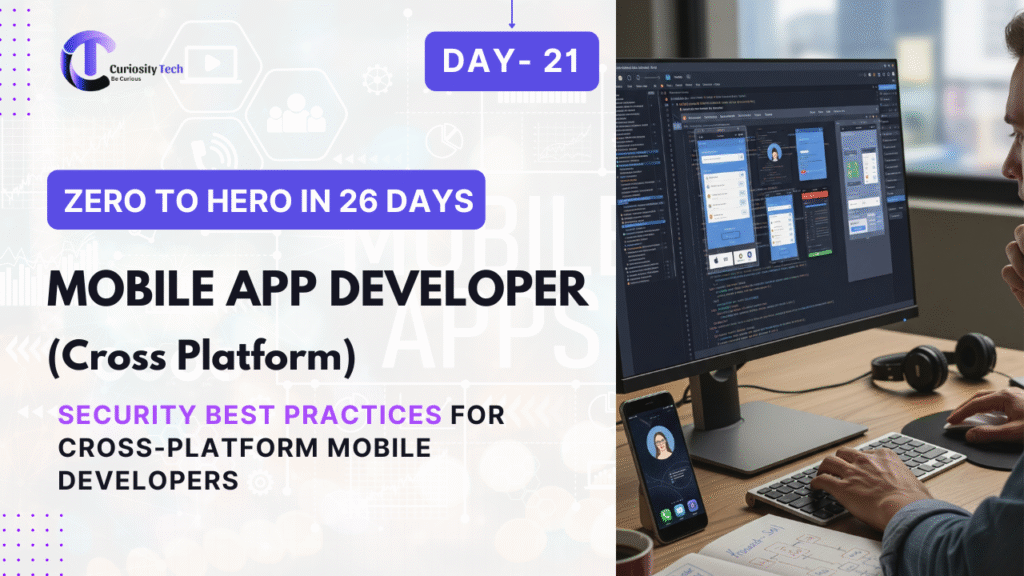Introduction
Security is one of the most critical aspects of mobile app development. Cross-platform apps developed in Flutter or React Native face unique challenges because the same codebase must run securely across multiple platforms. Data breaches, insecure storage, and weak authentication can compromise user trust and expose sensitive information.
In this blog, we will cover end-to-end security practices, including secure storage, API security, authentication strategies, encryption, and platform-specific vulnerabilities. This guide is for both beginners aiming to build secure apps and advanced developers seeking expert-level practices.
1. Secure Data Storage
Storing sensitive data improperly is one of the most common mobile security risks.
Flutter
- Use secure storage instead of SharedPreferences for sensitive data:
import ‘package:flutter_secure_storage/flutter_secure_storage.dart’;
final storage = FlutterSecureStorage();
await storage.write(key: ‘token’, value: ‘secure_token’);
String? token = await storage.read(key: ‘token’);
- Encrypt data stored in Hive using encryption keys:
var box = await Hive.openBox(‘secureBox’, encryptionCipher: HiveAesCipher(myKey));
React Native
- Use react-native-keychain or encrypted AsyncStorage for sensitive information:
import * as Keychain from ‘react-native-keychain’;
await Keychain.setGenericPassword(‘username’, ‘password’);
const credentials = await Keychain.getGenericPassword();
2. Secure API Communication
Example (Flutter HTTP with headers):
final response = await http.get(
Uri.parse(‘https://api.example.com/data’),
headers: {‘Authorization’: ‘Bearer $token’},
);
React Native (Axios example):
import axios from ‘axios’;
axios.get(‘https://api.example.com/data’, {
headers: { Authorization: `Bearer ${token}` }
});
3. Authentication Best Practices
- Multi-factor authentication (MFA) for sensitive apps.
- Biometric authentication (fingerprint/face ID) using local_auth in Flutter or react-native-touch-id.
- Token expiration and refresh flow to minimize risk.
4. Code Obfuscation & Protection
Cross-platform apps are vulnerable because JavaScript (React Native) or Dart (Flutter) code can be reverse-engineered.
Flutter:
flutter build apk –release –obfuscate –split-debug-info=/<project>/debug-info
React Native:
- Enable ProGuard and Hermes for code minification and optimization.
5. Handling Sensitive Permissions
- Only request necessary permissions: camera, location, microphone.
- Explain permission usage clearly to the user.
- Revoke unused permissions regularly.
6. Preventing Common Attacks
| Attack Type | Mitigation Strategy |
| SQL Injection | Use parameterized queries, avoid raw SQL strings |
| XSS (WebView) | Sanitize inputs when using WebView |
| Insecure Storage | Encrypt sensitive data with secure storage |
| Man-in-the-Middle | Enforce HTTPS, certificate pinning |
| Data Leakage | Clear cache & temporary storage on logout |
7. Monitoring & Logging
- Implement crash reporting and security logging without exposing sensitive data.
- Tools: Sentry, Firebase Crashlytics for monitoring.
- Monitor app analytics to detect suspicious behavior.
How to Become an Expert in Mobile Security
- Learn secure coding practices for Flutter and React Native.
- Understand OWASP Mobile Top 10 vulnerabilities.
- Regularly audit your app for vulnerabilities.
- Implement end-to-end encryption and authentication flows.
- Participate in bug bounty programs to sharpen security skills.
Integrating CuriosityTech
At CuriosityTech (https://curiositytech.in), we provide expert guidance in mobile app security for Flutter and React Native projects. From secure storage to API protection and encryption, we ensure your app adheres to industry standards. Contact us at +91-9860555369, email contact@curiositytech.in, or visit 1st Floor, Plot No 81, Wardha Rd, Gajanan Nagar, Nagpur. Follow our latest insights on Instagram: curiositytechpark, LinkedIn: Curiosity Tech, and Facebook: Curiosity Tech.
Conclusion
Security is a continuous process, not a one-time task. Cross-platform developers must implement encryption, secure storage, authentication, API protection, and code obfuscation to build trustworthy apps. Mastering these practices ensures your users’ data remains protected and your apps comply with industry standards.


